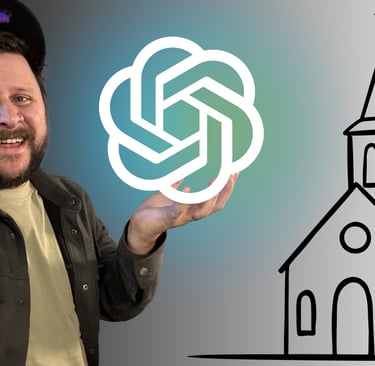Getting Started with ChatGPT: How AI in the Church Can Save You Time and Spark Creativity
Learn how to use ChatGPT in the church for youth ministry, flyers, and prompts. Save time with AI while keeping your ministry voice authentic.


The Struggle of a Busy Ministry Week
If you’ve ever scrambled to come up with youth group icebreakers five minutes before service or rushed to design a last-minute flyer, you’re not alone. Ministry life is full of unexpected tasks that pull you away from people. That’s where AI—specifically ChatGPT—can help lighten the load.
What Is ChatGPT and Why Does It Matter for Churches?
Think of ChatGPT as a virtual assistant or conversational search engine. You type in a request, and it gives you quick, thoughtful responses—like icebreaker questions, sermon outlines, or even flyer text.
The real power? You can talk to it conversationally. Instead of just Googling “youth icebreakers,” you can ask:
“Give me three funny icebreaker questions for a middle school youth group.”
And within seconds, you’ll have ready-to-use ideas.
For pastors and small church staffs juggling multiple roles, ChatGPT can save precious time while sparking creativity.
Prompting Well: The Key to Useful AI Output
The secret to using ChatGPT effectively is writing good prompts. Here’s a simple 3-step framework:
Set the role. Tell it who it is. (e.g., “You are an experienced graphic designer.”)
Explain the task. Be specific about what you need.
Define the output. Share details like format, style, or tone.
For example, instead of just saying “Make me a flyer,” you might say:
“You are a graphic designer with 20 years of experience. Create a flyer for a youth group pool party this Saturday at 4 PM. Use a fun, illustrated style in vertical 16:9 format.”
With a clear prompt, you’ll get results you can actually use—and tweak to fit your church’s unique voice.
Quick Tips for Using ChatGPT in Ministry
Always review before posting. AI can make mistakes. Double-check for accuracy and fit.
Add your church’s personality. Adjust the wording so it sounds like you.
Think timesaver, not replacement. AI doesn’t replace prayer, presence, or pastoral care—it frees up time for them.
One Example: Wesley AI
There are many AI tools out there, but one example built specifically for churches is Wesley AI. Like ChatGPT, it helps with writing, planning, and content creation, but it’s designed with pastors in mind. Tools like this can take care of the small details, so you can focus more on people and discipleship.
A Wesleyan Perspective on Technology
John Wesley once said: “Do all the good you can, by all the means you can.” Technology is one of those means. When used wisely, AI can help us steward time well, amplify ministry, and clear space for deeper relationships.
Where to Start with ChatGPT
Visit chat.openai.com and create a free account.
Try a simple prompt: “Give me three icebreaker questions for a youth group.”
Experiment with refining your prompts for flyers, announcements, or small group guides.
Closing Encouragement
Remember: AI is just a tool. It won’t preach the gospel, disciple students, or pray for people—but it can give you back the gift of time. Use it to serve your ministry, not replace it, so you can focus on the most important work: loving people into the kingdom.

